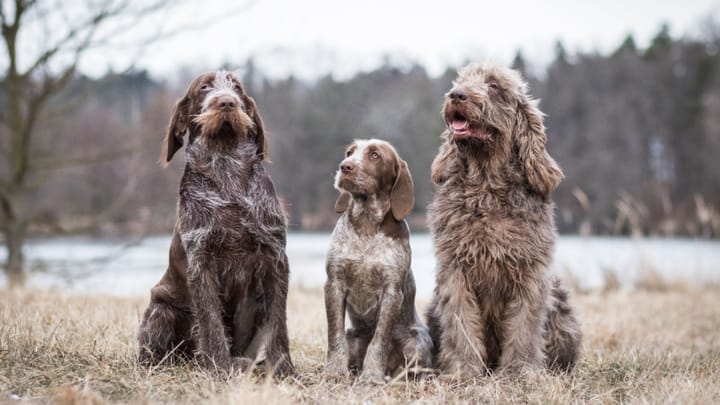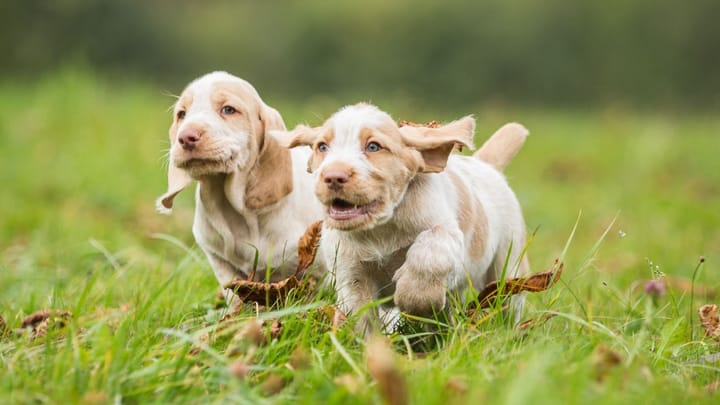Italian Spinone
Other name: Spinone Italiano


Docile and gentle, this hunting and pointing breed of dog has ancestry dating back many years. The Spinone Italiano makes both a great dog to exercise with and also a fantastic family pet. His name is taken from the type of coat he has, the “spino”, wiry and thorn-repellent hair. A sturdy, dependable dog with an amazing zest for life. Likewise, very easy-going and adaptable. He can be out hunting one day, then loves spending the next day hiking with his family.
|
Life expectancy |
The Italian Spinone has a life expectancy of between 12 and 14 years |
|
Temperament |
|
|
Size |
Large
|
|
Adult size |
Female
Between 23 and 26 in
Male
Between 24 and 28 in
|
|
Adult weight |
Female
Between 62 and 66 lb
Male
Between 71 and 82 lb
|
|
Coat colour
Varied markings and coat colours ranging from all-over white, orange and white, orange and roan and any variety of these colours with orange or chestnut brown markings. |
White Sand |
|
Type of coat
Medium length hair apart from on the front of the legs, muzzle, ears and head, where the hair is of a shorter length. This dog has a water-resistant coat that is very wiry and dense in texture. He also has a beard, moustache and stiff eyebrows to help protect against cuts from bushes and the undergrowth, when hunting. |
Long Hard |
|
Eye colour
Brown or yellow-amber |
Brown
|
|
Purchase price |
The Italian Spinone costs between £1030 and £1170 |
Like many dogs with a shaggy, unkempt coat, the Spinone Italiano dog can be quite messy. After an energetic hike he will probably have mud, grass and other matter clinging to his rough coat. He won’t mind if he leaves this debris deposited through your house when he returns home. Similarly, he tends to drool or slobber and when eating his food, this often clings to his facial hair. He only needs to cuddle up to you after feeding and you will be covered in food debris and saliva. He also sheds his coat, so all in all, he’s not a very fastidious house guest.
More details about the Italian Spinone
Italian Spinone: Origins and history
In European countries, various regions developed and bred pointing and hunting canines depending on the type of game and of course, the terrain of the country. Because of this, the Spinone Italiano was first developed some 300 years ago, as an Italian Pointer dog. Initially, it was bred in the north west of Italy, in the Piedmont region. The parent dogs used to develop the breed are thought to have been a French Griffon and a white Mastiff, to produce a perfect hunting and pointing offspring.
Physical characteristics of the Italian Spinone
With the appearance of a square, muscular body, this Italian Spinone breed is very powerful and strong. Sporting a long head and either dark brown or amber eyes, depending on the colour of his coat. Triangle-shaped ears that hang down and a tail that swishes from side to side when he is at work.
These dogs are very endearing with their “human-like” expressive face. You would sometimes think that he is smiling at you.
FCI classification of the Italian Spinone
-
Group 7 - Pointing Dogs
-
Section 1 : Continental Pointing Dogs
Italian Spinone: Characteristics
Italian Spinone: Behaviour
Training a Italian Spinone
Certainly a dog that is eager to please his master. He responds well to consistent, fair training, especially when these routines have begun at an early age. These charming dogs pick up new things very quickly, although this also means that they collect bad habits quite easily too!
Italian Spinone: Lifestyle
Breed compatibility Italian Spinone
Italian Spinone: Purchase price
Expect to pay between £1,030 for a Non KC Registered and £1,170 for KC Registered dog. You may need to be added to a waiting-list with a certified Spinone Italiano breeder in the UK, as not many pups are registered annually.
Providing a good-quality, nutrient rich dog food to meet the dogs energy levels will cost between £50 and £60 monthly. You also need to take into account the costs to spay or neuter your pup, vaccinations, pet insurance and annual veterinary examinations. Then the monthly cost increases to between £80 and £100.
Italian Spinone: Shedding
Average
Yes, the Spinone Italiano dog sheds his coat frequently. Obviously, frequent grooming and stripping of his coat can help with this hair loss.
Italian Spinone: Grooming
With a wiry, dense coat, the Spinone Italiano needs only occasional grooming to keep him looking good. His coat is also weather-resistant and gives him protection when hunting through the undergrowth, in all weathers. To remove any dead hair from the dog’s coat, hand stripping is necessary. Occasional bathing is recommended, but as the Spinone tends to drool onto his moustache and beard, especially when eating and drinking, a quick facial clean up on a daily basis is advised. As a hunting breed, his ears will need to be checked for burrs and debris. Likewise, good dental hygiene ensures that your dog will have clean breath.
Italian Spinone: Health
When a dog is properly cared for and given a high-quality diet, the Spinone Italiano is expected to have a lifespan of between 12 and 14 years.
This dog is quite determined in any task, and can hunt all day long without tiring. Equally as happy spending time at home with their human family and lazing on the sofa.
The Spinone breed is quite happy in all climates and has no problem when the weather is warmer.
The Spinone has a dense and wiry coat that certainly gives protection during cold weather periods. This breed loves to swim, even in deep, cold water, which doesn’t usually cause a problem.
As a very energetic and active dog, this breed doesn’t easily put on weight. However, a less active Spinone, who enjoys lazing around the home rather than getting lots of exercise outside, will certainly be more prone to weight gain.
- Addison’s disease – a life-long health condition that mainly affects young adult females
- Cerebella Ataxia – predominantly affecting male dogs that produces symptoms of weakness and in-coordination
- Eclampsia – can be potentially fatal in bitches
- Hip and Elbow dysplasia – a significant cause of lameness in dogs








